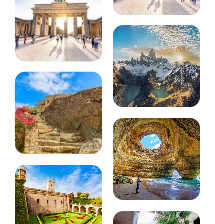
Visit Santorini: 10 must-sees for exploring the Cycladic Capital
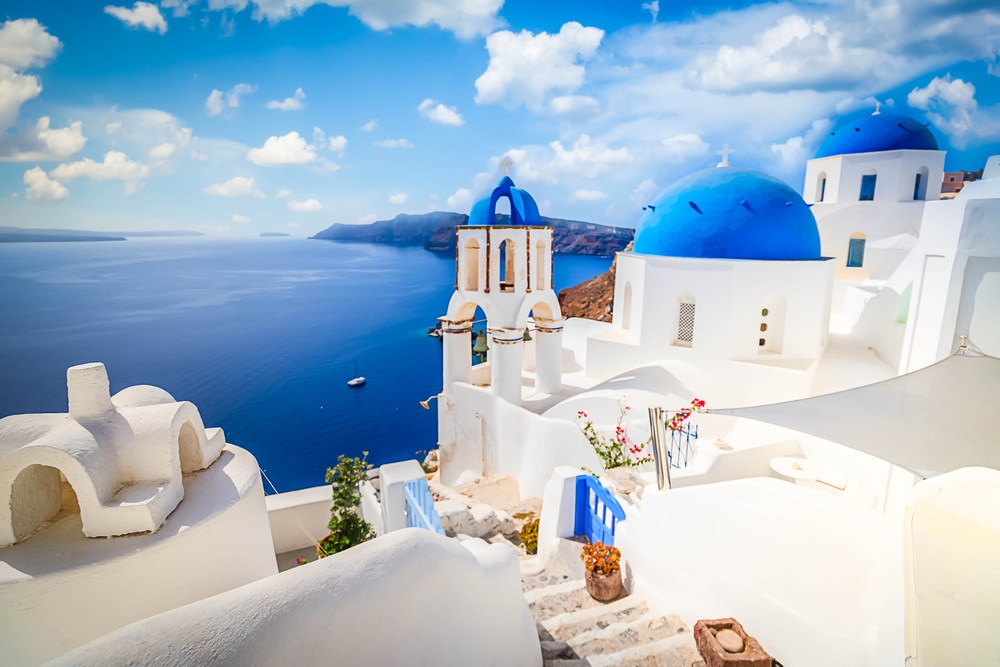
Perched in the heart of the Aegean Sea, Santorini fascinates with its spectacular beauty. Its white villages suspended above the caldera, its legendary sunsets and its volcanic-coloured beaches make this Greek island a dream destination. Between strolling through the narrow streets of Oia, discovering the archaeological site of Akrotiri and tasting local wines, visiting Santorini promises an unforgettable experience. Whether you’re a history buff, a lover of breathtaking panoramas or in search of unique beaches, the island offers a range of activities and must-see sites that appeal to all travellers.

Download the audio tour to discover Fira on foot and on your own
Explore Santorini’s capital with an audio tour that takes you through picturesque alleyways, blue domed churches and spectacular views of the caldera. This interactive route lets you visit Fira at your own pace, discovering the secrets of this town perched between sky and sea. With 16 entertaining audio guides, let yourself be guided as you explore the capital of the volcanic Cyclades and enjoy enriching historical commentary on each landmark.
Read also about the Greece guide :
- Discover Athens, the cradle of Western civilisation
- Visit Fira, the capital of Santorini
- When to go to Santorini Climate, crowds and advice for each season
- The 20 most beautiful Greek islands to visit
1. The village of Oia, the jewel of Santorini
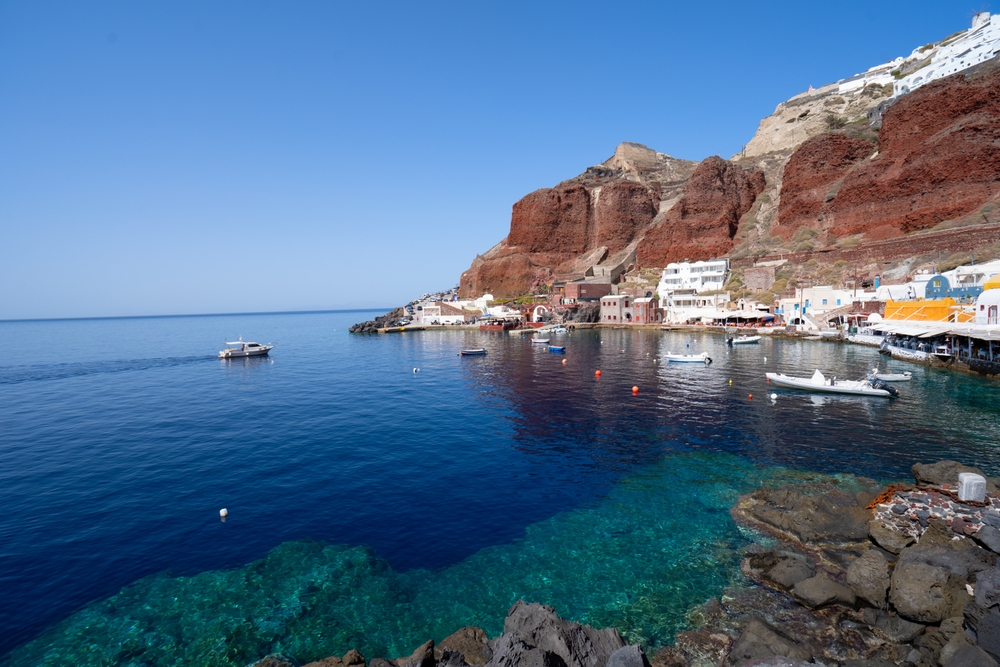
Oia represents the very essence of Santorini and is arguably the most photographed village in the Cyclades. Perched on the north-western cliffs of the island, this village is postcard perfect with its traditional white houses, iconic blue domes and windmills towering majestically over the caldera. Each cobbled alleyway reveals a new perspective on the Aegean Sea, while art galleries, elegant boutiques and restaurants with panoramic terraces invite you to take a stroll.
The Byzantine castle of St Nicolas, although partially in ruins, remains the place to be if you want to admire Santorini’s famous sunset. From late afternoon onwards, visitors flock to witness this natural spectacle as the sun plunges into the Aegean Sea, tinting the sky in shades of orange, pink and purple. It would be a shame to visit Santorini without witnessing this magical moment from Oia.
Regular, inexpensive buses run between Fira and Oia in 20 to 40 minutes, making the village easily accessible. To make the most of Oia’s peaceful atmosphere, it’s best to visit in the morning before the day-trippers arrive. This will reveal the authenticity of the narrow streets and make for infinitely more pleasurable photographic opportunities(Locate Oia on Google Maps, rated 4.7/5 on Google with over 45,000 reviews).
2. Fira, the island’s lively capital
Perched 260 metres above the ochre cliffs, Fira is the vibrant capital of Santorini. Its white and blue Cycladic architecture, authentic local life and bustling tourist industry are a delightful contrast to the tranquillity of other villages. Bars and restaurants with terraces overlooking the caldera, colourful boutiques, fascinating museums such as the prehistoric museum of Thera and majestic Orthodox churches make up the picture of a dynamic and engaging town.
A memorable experience is to descend the 600 steps to the old port, then take the cable car back up for a unique view of the caldera. The more adventurous can also take the donkey ride, a local tradition that adds a picturesque touch to the visit. Fira is the ideal starting point for exploring Santorini, thanks to its central bus station serving the whole island and its proximity to the airport and ports.
The capital also offers the widest choice of accommodation, restaurants serving traditional Greek cuisine and local specialities, and a lively nightlife. If you want to visit Santorini conveniently and enjoy the cosmopolitan atmosphere, Fira is the ideal base. The Navaway audio tour lets you discover all the treasures of this Cycladic capital at your own pace (Locate Fira on Google Maps, rated 4.5/5 on Google with over 38,000 reviews).
3. Imerovigli, the Aegean balcony

Imerovigli fully deserves its nickname of ‘balcony of the Aegean’ thanks to its spectacular views of the volcano and caldera from 300 metres up on the cliff tops. This typical Cycladic village boasts quiet lanes, whitewashed troglodyte houses, distinctive blue domes and luxury hotels with infinity pools that seem to defy the laws of gravity.
Situated on the hiking trail between Fira and Oia, Imerovigli offers a much more serene atmosphere than its famous neighbours, ideal for savouring intimate sunsets or fine local cuisine in a romantic setting. Skaros Rock, the remains of an ancient Venetian fortress perched on a rocky outcrop, is the village’s star attraction. Accessible via a path offering exceptional panoramic views, this historic site fascinates lovers of photography and history.
For those who want a different way of visiting Santorini, away from the crowds but with some of the best views on the island, Imerovigli is a must (Locate Imerovigli on Google Maps, rated 4.6/5 on Google with over 12,000 reviews).
4. Hiking between Fira and Oia along the caldera
The hike between Fira and Oia is one of the most memorable ways to visit Santorini. This spectacular trail is around 10 kilometres long and takes 3-4 hours to complete, skirting the cliffs of the caldera with breathtaking views of the Aegean Sea at every turn. The path passes through the picturesque villages of Imerovigli and Firostefani, offering plenty of opportunities for photo stops in front of the iconic blue-roofed churches.
This walk is best done from April to October, when temperatures remain pleasant despite the Mediterranean sun. Bring comfortable hiking boots, several litres of water and effective sun protection, as the trail offers little shade. The unique volcanic landscape and the dazzling whiteness of the typical buildings make this hike one of the most beautiful experiences to be had in the Cyclades.
The path is well-maintained and signposted, ensuring that you never get lost while discovering unique views of the caldera. There are plenty of cafés and tavernas along the way for refreshments. This panoramic walk reveals Santorini’s rugged beauty from a different angle, far from the usual tourist trails.
5. The archaeological site of Akrotiri, the Pompeii of the Cyclades
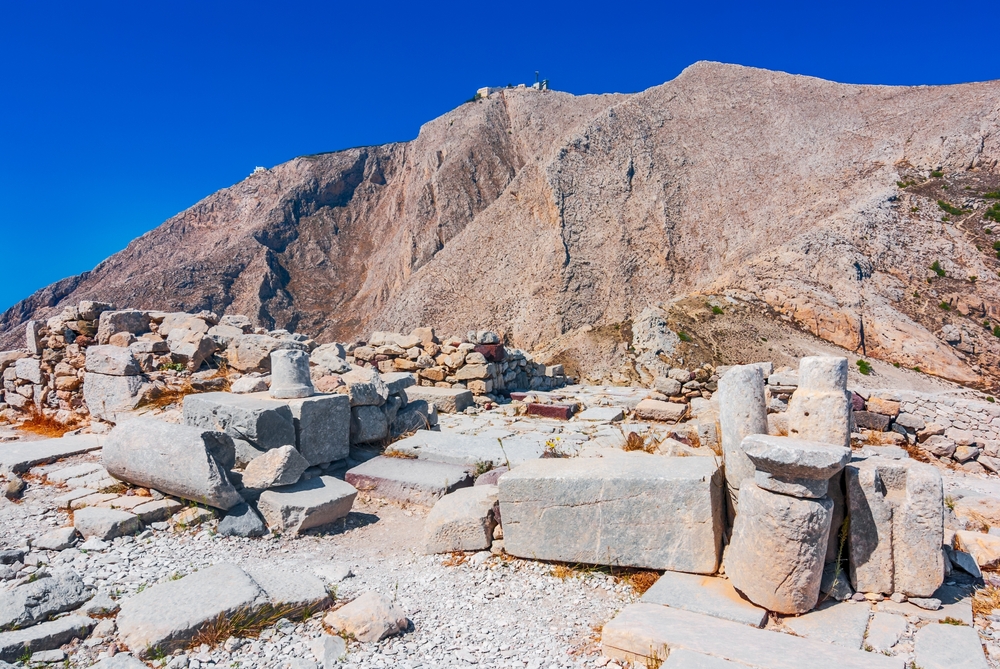
The ancient site of Akrotiri, in the south of the island, is a dream come true for history buffs visiting Santorini. This exceptionally well-preserved Minoan city bears witness to a flourishing Bronze Age civilisation that was brutally buried under volcanic ash during a cataclysmic eruption around 1600 BC. Excavations, begun in the 1960s by the Greek archaeologist Spyridon Marinatos, have revealed remarkable colourful frescoes, sophisticated pottery and entire streets frozen in time.
A modern covered tour allows visitors to explore these fragile ruins while protecting them from the elements. The quality of preservation of the structures, drainage systems and even some of the furnishings offer a fascinating insight into daily life more than 3,500 years ago. The wall frescoes discovered here, now on display at the Thera Archaeological Museum in Fira, are among the finest of Greek antiquity.
Bring good shoes and expect a hot climate, especially in summer. Don’t miss the view over the nearby caldera to understand the scale of the volcanic eruption that shaped the present-day face of Santorini and perhaps inspired the legend of Atlantis(Locate Akrotiri on Google Maps, rated 4.5/5 on Google with over 18,000 reviews).
6. Santorini’s volcanic beaches: Red Beach and Black Beach
Santorini’s volcanic beaches, born of the island’s intense geological activity, stand out for their unique colours, which create a striking contrast with the brilliant blue of the Aegean Sea. Red Beach, near the archaeological site of Akrotiri, impresses with its deep red cliffs encircling a dark pebble beach. This spectacular natural site, accessible by a short rocky path, attracts photographers from all over the world who come to capture this unique lunar landscape.
The beaches of Perissa and Perivolos offer long stretches of black volcanic sand, ideal for water sports, swimming and relaxing. Lined with beach bars, restaurants and deckchair hire, they offer all the facilities you need for a successful day at the beach. Kamari has a long seafront promenade with restaurants serving fresh fish and Greek specialities.
To get to these beaches, take a bus from Fira or hire a car for greater freedom. Choose the period from May to October to enjoy the warm waters and fully operational tourist infrastructure. To visit Santorini without discovering its unique volcanic beaches would be to miss out on a rare geological experience (Locate Red Beach on Google Maps, rated 4.3/5 on Google with over 12,000 reviews).
7. Cruise to Nea Kameni and the hot springs
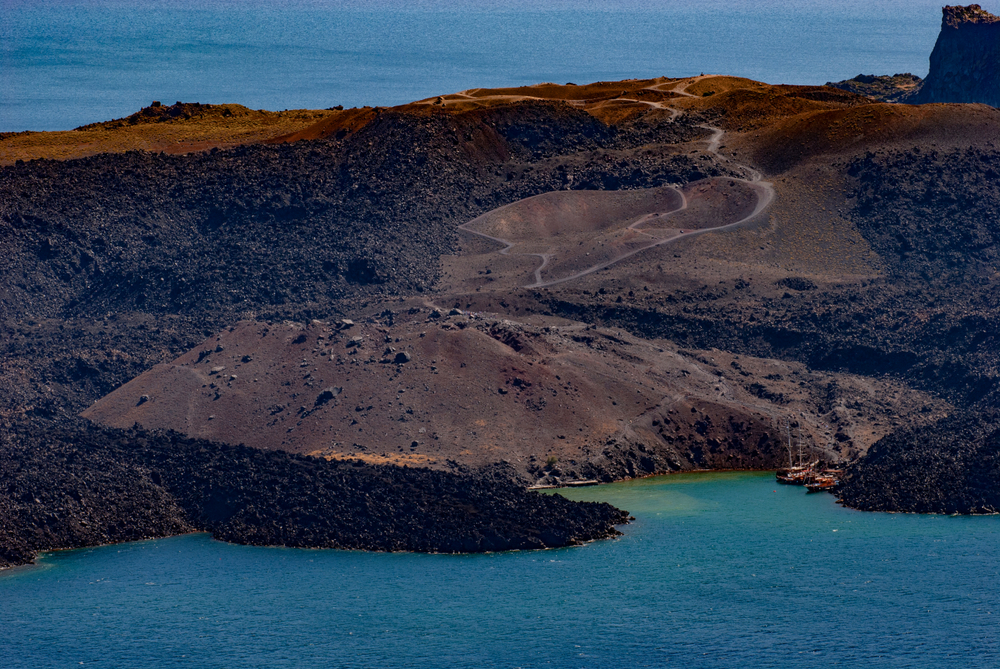
Taking a boat cruise to Nea Kameni and exploring the Santorini caldera is a rare natural experience. This small volcanic island at the heart of the caldera is the result of successive eruptions that have shaped the entire archipelago. Its last major eruption took place in 1950, leaving behind a fascinating lunar landscape of black rock and smoking craters.
You can reach the island by boat from the port of Athinios, Santorini’s main port, or from Fira. Once there, a signposted path leads to the top of the volcano, where you can see the fumaroles and feel the heat still emanating from the ground. The panoramic view of the caldera, formed by the massive eruption more than 3,600 years ago, is simply breathtaking and helps you understand the geological power that sculpted this unique landscape.
Most excursions also include a stop at the Palea Kameni hot springs, where you can bathe in water naturally heated by volcanic activity. These sulphur-rich waters have a characteristic orange colour and hover around 30°C, making for a hot bath in the middle of the sea. Remember to wear old swimming trunks as the sulphur can stain. This unique experience allows you to visit Santorini from a fascinating geological angle(Locate Nea Kameni on Google Maps, rated 4.5/5 on Google with over 8,000 reviews).
8. Traditional villages: Pyrgos, Megalochori and Emporio
Situated in the interior of the island, far from the hustle and bustle of the caldera, Pyrgos, Megalochori and Emporio offer a more peaceful and authentic Santorini, with typical Cycladic architecture. Pyrgos, Santorini’s former capital until the early 19th century, invites you to explore a labyrinth of narrow streets that wind their way to the top of the village where the Theotokaki church, one of the island’s oldest, stands enthroned.
Megalochori is particularly renowned for its traditional wine cellars carved out of volcanic rock, its local craft shops and its unspoilt village atmosphere. Restored captains’ houses and shady squares invite you to stroll around and meet the locals. Emporio, Santorini’s largest village, is home to a remarkably well-preserved medieval Venetian castle, the Kasteli, whose labyrinthine alleyways tell the story of centuries of history.
The traditional tavernas in these villages offer authentic local specialities, including the famous Santorini fava (mashed yellow split peas), sun-dried cherry tomatoes and local goat’s cheese. Accessible by car or bus from Fira, these villages are well worth exploring for several hours to stroll around and chat with the locals, who will be happy to share their best tips for visiting Santorini(Locate Pyrgos on Google Maps, rated 4.6/5 on Google with over 15,000 reviews).
9. Sunsets from panoramic viewpoints
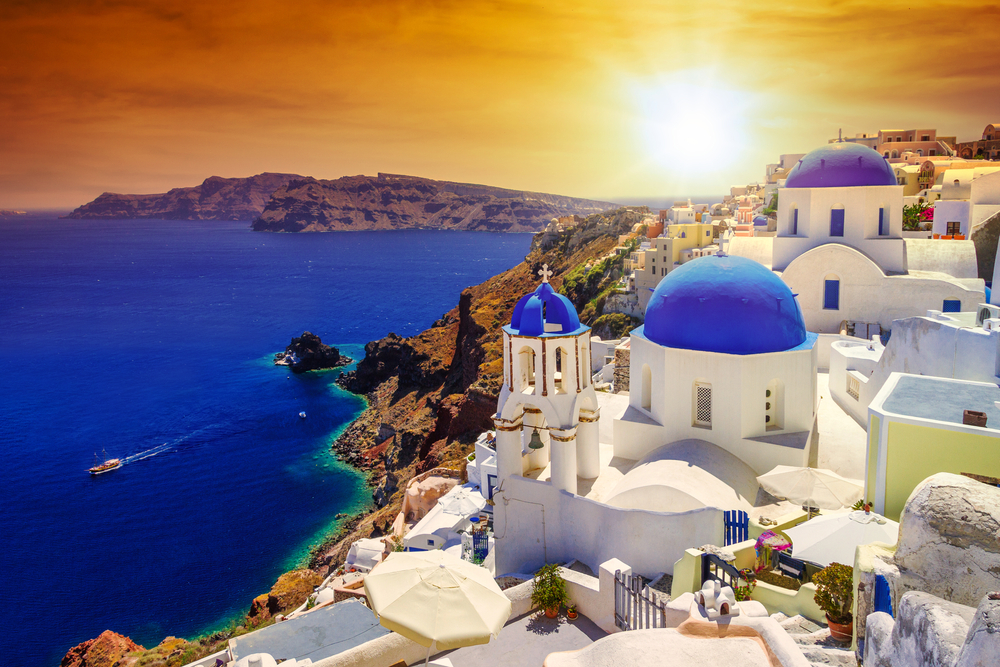
Santorini’s famous sunsets offer an unforgettable spectacle in which the volcanic cliffs, the Aegean Sea and the white villages are adorned with magical colours ranging from gold to pink to deep purple. The two most popular vantage points for admiring this natural phenomenon are Oia Castle, which attracts hundreds of visitors every evening, and the caldera of Imerovigli, which is slightly less popular but just as spectacular.
At the southern tip of the island, the Akrotiri lighthouse also offers a splendid and different panorama at the end of the day, with a more intimate atmosphere and fewer crowds. Sunset from the top of Profitis Ilias mountain, the highest point on the island at 567 metres above sea level, provides a truly exceptional 360-degree panoramic view of the whole island and surrounding archipelago. From Fira, you can also enjoy magnificent sunsets from the many terraces perched on the caldera.
Plan to arrive at least an hour before sunset to ensure you are comfortably seated, as these places are very busy. From May to September, the sun sets between 8pm and 9pm, giving you plenty of time to explore the narrow streets and surrounding area before settling in. This is one of the most unforgettable visual and emotional experiences for anyone dreaming of visiting Santorini.
10. Discover Santorini’s wines and vineyards

A visit to Santorini also means discovering a thousand-year-old wine-growing tradition that is unique in the world. Vines have been grown on the island since ancient times, and the local grape varieties, particularly Assyrtiko, develop exceptional flavours thanks to the mineral-rich volcanic soil and dry, windy climate. Winegrowers cultivate the vines in spirals at ground level, forming protective baskets called ‘kouloures’ against the violent winds of the Aegean Sea, a viticultural technique that is unique in the world.
Numerous wineries open their doors for tastings and guided tours to help visitors understand the special characteristics of Santorian viticulture. The vineyards of Estate Argyros, Gavalas Winery, Santo Wines and Venetsanos offer not only excellent wines but also spectacular panoramic views of the caldera. The Koutsoyannopoulos Wine Museum, housed in an ancient troglodyte cellar 8 metres below ground, traces the fascinating history of Santorini’s winegrowing since ancient times.
Taste local wines accompanied by local produce such as candied cherry tomatoes, fava, capers and local cheeses. Dry, mineral Assyrtiko, oak-aged Nykteri and Vinsanto, a complex amber dessert wine, are the island’s three signature styles. This oenological discovery adds an unforgettable gastronomic dimension to your visit to Santorini. Let us guide you on your exploration of the island, starting with a visit to Fira, the ideal starting point for exploring the vineyards.
Frequently asked questions about Santorini
How do I get to Santorini?
The quickest way to get to Santorini is by plane. From France, there are direct flights or flights with stopovers from the main airports (Paris, Lyon, Marseille, etc.). Another option is to land in Athens and then take the ferry to Santorini from the port of Piraeus (around 5 to 8 hours, depending on the type of boat) or a domestic flight (around 45 minutes). The ferries offer a great experience of travelling across the Aegean Sea, with spectacular views as you approach the caldera.
Where to stay in Santorini?
If you’re looking for a lively atmosphere with plenty of restaurants, bars and shops, choose Fira, the island’s nerve centre. For breathtaking views of the caldera in a quieter but equally romantic setting, Imerovigli and Firostefani are ideal choices. If you’re dreaming of legendary sunsets and white facades as far as the eye can see, Oia is a must, even if prices are generally higher. Finally, if you prefer a seaside break or a quieter, more authentic atmosphere, head for the beaches of Kamari or Perissa, or the traditional villages of Pyrgos and Megalochori.
When is the best time to visit Santorini?
The period between late April and early November is ideal for visiting Santorini. May, June and September offer the best compromise, with pleasant temperatures (20-28°C), moderate visitor numbers and more reasonable prices than in the high season. July and August see a large influx of tourists and high temperatures (28-33°C), but also a festive atmosphere and all the establishments open. Winter (November to March) remains calm with mild temperatures (12-18°C), but many hotels and restaurants close.
Can you visit Santorini without a car?
Yes, it’s perfectly possible to visit Santorini without a car, thanks to the public bus network that efficiently serves the island’s main villages and beaches. Fira is the central hub from which all routes depart. Taxis and private transfer services are also practical alternatives. For even greater flexibility, hire a scooter, quad bike or electric mountain bike and discover the island at your own pace while enjoying the spectacular scenery.
How long does it take to visit Santorini?
A stay of 3 to 5 days is a comfortable way to discover Santorini’s main must-see sites: the caldera villages (Oia, Fira, Imerovigli), the archaeological site of Akrotiri, a few volcanic beaches, a cruise to the volcano and the vineyards. For a more leisurely pace, with time to relax on the beaches and explore the less touristy villages, allow 5 to 7 days. A 2-day weekend may be enough to see the essentials, but the trip will be very fast-paced.
In conclusion, visiting Santorini is an unforgettable experience that harmoniously blends natural beauty, rich history and the Greek way of life. From white villages perched on the caldera to unique volcanic beaches, fascinating archaeological sites and centuries-old vineyards, the island offers a diversity of experiences that appeal to all types of traveller. Whether you’re a lover of romantic sunsets, an enthusiast of ancient history, a panoramic hiker or an epicurean in search of authentic flavours, Santorini will enchant you. Take time to lose yourself in the narrow streets of Oia, gaze at the caldera from Imerovigli, swim in the warm waters of the volcano and taste the local wines as the sun sets. Start your discovery by exploring Fira with the Navaway audio tour, which allows you to visit Santorini’s capital at your own pace and in complete autonomy. This magical island in the Cyclades promises lasting memories and an irresistible desire to return.
200 audioguided tours for cities all around the world
Download